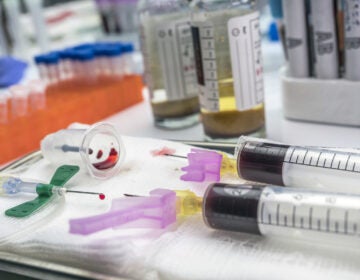No, Philly twin newborns on ‘missing’ posters were not abducted from Thomas Jefferson University Hospital
Infant abductions from hospital and health care settings have happened, but federal data show they’ve become more rare over time.

Pedestrians walk past Thomas Jefferson University Hospital in Philadelphia, Monday, Oct. 4, 2021. (AP Photo/Matt Rourke)
From Philly and the Pa. suburbs to South Jersey and Delaware, what would you like WHYY News to cover? Let us know!
The photos of newborn twins, wearing little blue caps and swaddled in blue blankets, have been circulating on social media and grabbing the attention of people living or working in the Greater Philadelphia area.
The tiny faces, full names and ages appear under a bold red banner with the word “MISSING,” stating that the 2-month-old twins were last seen on June 8 in Philadelphia.
On one version of a poster, it says they were last seen at Thomas Jefferson University Hospital.
It turns out the twins are not missing, but are involved in a “civil matter” and an ongoing custody case, according to the Philadelphia Police Department. The department said Friday that police have confirmed that the twin infants were released to their mother at the hospital and that detectives are currently in contact with the city Department of Human Services, Sheriff Department and the District Attorney’s Office regarding the custody issue.
An investigation “is active in trying to ascertain [where] the children are located,” police said.
Officials at Thomas Jefferson University Hospital also confirmed in a statement that there have been no reported violations of the hospital’s discharge policy regarding infants, who are released only to legal parents, guardians or to the city Department of Human Services, which oversees child welfare cases.
Still, well-meaning people continue to raise the alarm and share posters on social media that indicate the newborns went missing from the local hospital. Abductions from maternity wards have become extremely rare thanks to new and more extensive security measures and practices.
“Hospitals do a lot of planning and prepping and practicing for these events,” said Dan Yaross, a security risk management consultant who worked for children’s hospitals in Ohio for more than 20 years.
About 140 infants in the United States were abducted from health care facilities between 1964 and April 2024, according to the National Center for Missing & Exploited Children. Over a roughly 60-year period, abductions in these kinds of settings significantly declined compared to abductions from private homes and other places, data show.
Yaross, president-elect of the International Association of Healthcare Security and Safety, said many hospitals use advanced technology to thwart attempted abductions. For example, to enter or exit some of these inpatient units, visitors may have to use badges or key cards specifically programmed by hospital security to only allow access to certain doors or areas in the facility.
Hospitals also put bracelets or monitors on infants that can track their whereabouts in real-time, and alert security when they are in a place they shouldn’t be.
“If someone did try taking a baby off the unit and didn’t have it approved, it would go into an alarm,” Yaross said. “Doors would automatically secure and stay locked until the system was reset, meaning security got up there and were able to reset the system.”
Infants are also assigned ankle or wristbands with information that matches a wristband on their parent or legal guardian. When they are moved within the hospital, staff will scan those bands to make sure they match at all times.
Hospitals will also work with parents and guardians to create a list of approved visitors, who will need to check in at a main entrance in order to gain entry to an inpatient unit.
Some facilities are going above and beyond and adding an extra step, Yaross said. This involves assigning each patient, or a patient’s caregiver, an individual three-digit code that visiting family or friends must use when checking in at the front desk.
“So, when a guy would walk in or a lady would walk to the front desk, says, ‘I’m here to see Johnny Smith, the visitor code is 155,’ staff would look that up, look at the patient, see that the code is in the visitor management system — boom, yeah, you’re permitted,” Yaross said.
And then there are the obvious security tools and systems: surveillance cameras. A lot of them.
Yaross said one of the hospitals he used to work at in Ohio is now using up to 3,000 cameras that can monitor most parts of the health care campus and be used to precisely track anyone who is trying to leave the hospital with an infant or child.
But even with all these systems and protocols in place, Yaross said nothing is perfect and abductions still happen. Sometimes it’s due to human error and a failure to follow the right protocols. Other times, it may involve complex situations, like when there are certain custody arrangements.
“One parent decides, ‘I’m taking the child’ without telling the other parent or telling the hospital. That happens,” he said. “You know, you have only so many nurses and you don’t have a nurse sitting in every room 24/7. You have all these other practices and procedures that you try to follow, but if you have a custodial parent and non-custodial parent and they’re fighting and arguing and whatever, and both are still allowed to visit the patient, it makes it tough on staff. That’s where it really takes a lot of collaboration and coordination.”
To report a missing child, call your closest law enforcement agency or police department. Afterward, families can contact the National Center for Missing & Exploited Children at 1-800-843-5678 for help and support, or to report the sighting of a missing child.

Get daily updates from WHYY News!
WHYY is your source for fact-based, in-depth journalism and information. As a nonprofit organization, we rely on financial support from readers like you. Please give today.





